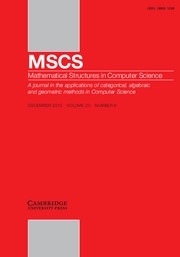Article contents
Concurrent computing machines and physical space-time
Published online by Cambridge University Press: 16 October 2003
Abstract
Concrete computing machines, either sequential or concurrent, rely on an intimate relationship between computation and time. We recall the general characteristic properties of physical time and of present realisations of computing systems. We emphasise the role of computing interferences, that is, the necessity of avoiding them in order to give a causal implementation to logical operations. We compare synchronous and asynchronous systems, and give a brief survey of some methods used to deal with computing interferences. Using a graphic representation, we show that synchronous and asynchronous circuits reflect the same opposition as the Newtonian and relativistic causal structures for physical space-time.
- Type
- Paper
- Information
- Copyright
- 2003 Cambridge University Press
- 2
- Cited by


